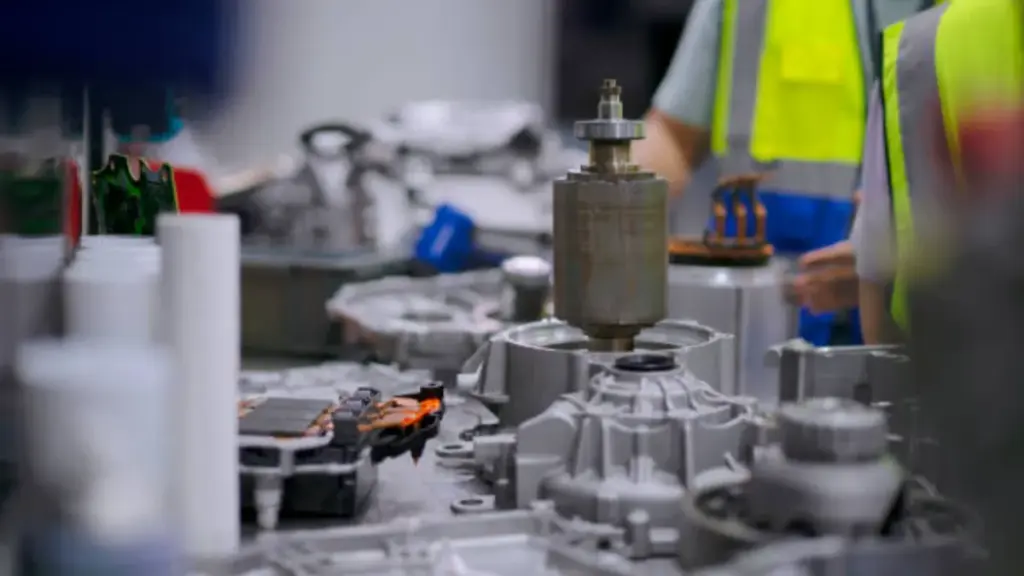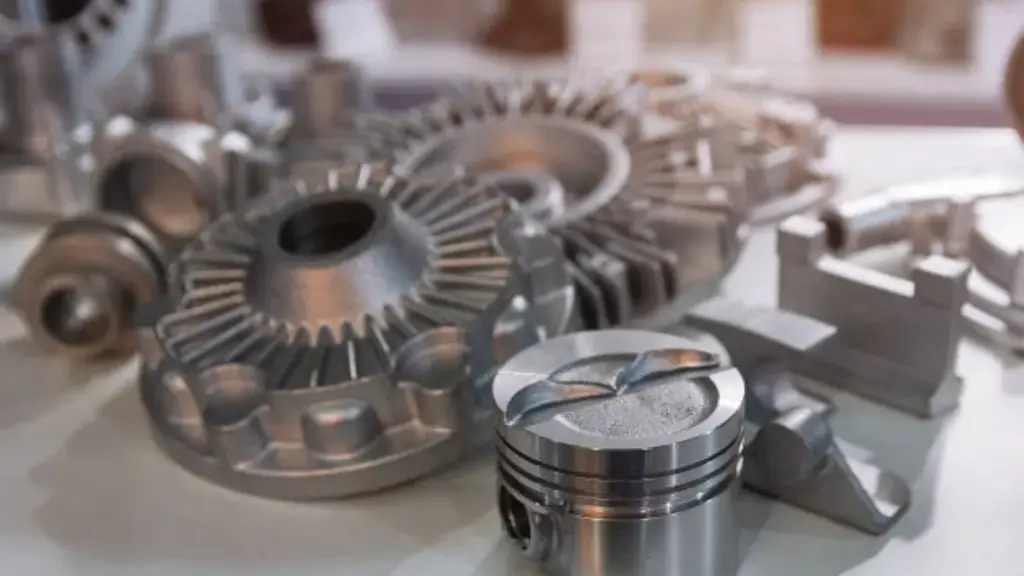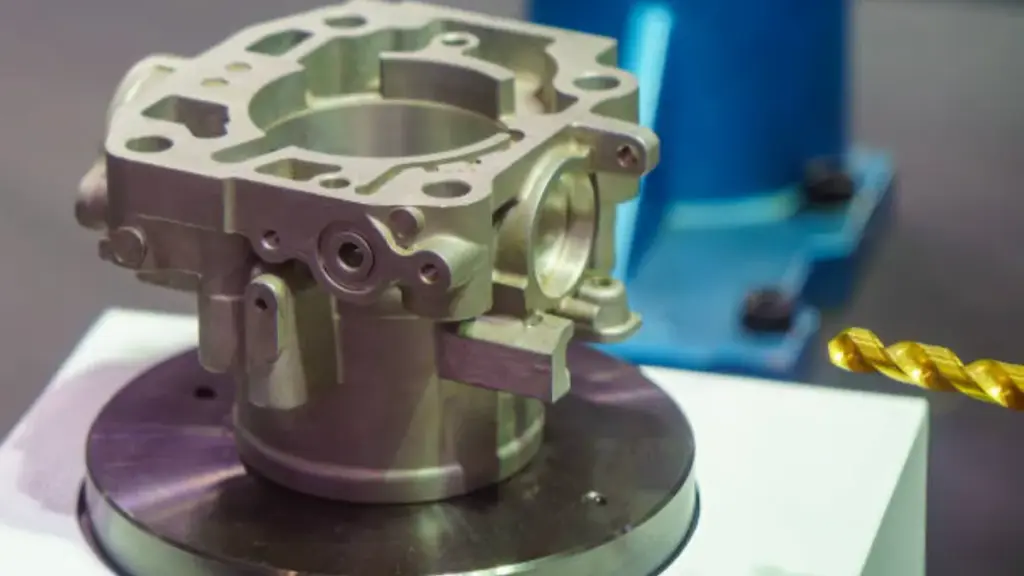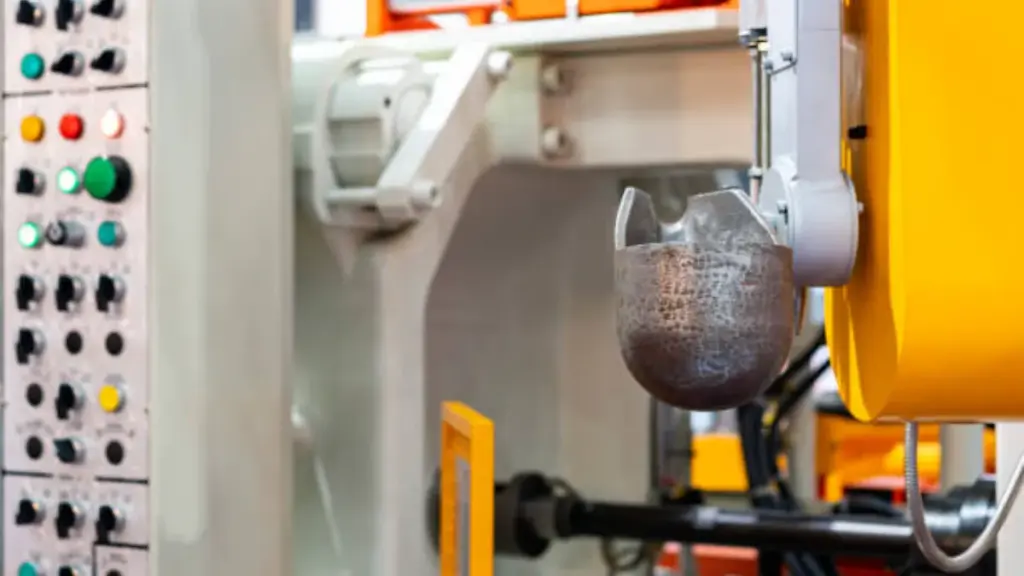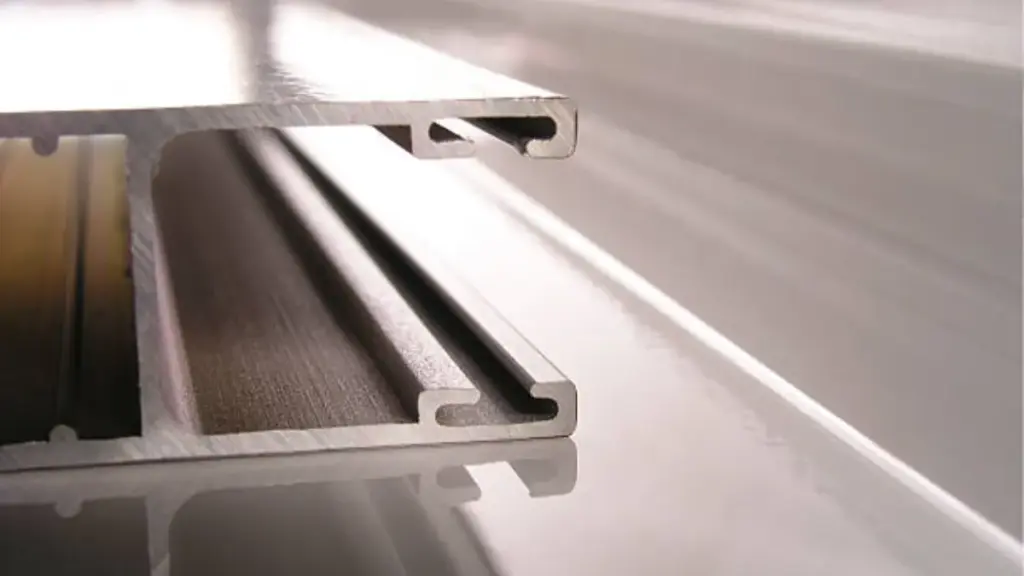La fundición a presión es un proceso de fabricación ampliamente utilizado que implica la producción de piezas metálicas mediante Forzar metal fundido dentro de una cavidad de molde usando alta presión.. Es un método versátil y rentable que permite la producción de formas complejas con tolerancias estrictas.. Este artículo explorará los conceptos básicos de la fundición a presión., los materiales utilizados, varios procesos de fundición a presión, y sus aplicaciones en todas las industrias.
¿Qué es la fundición a presión??
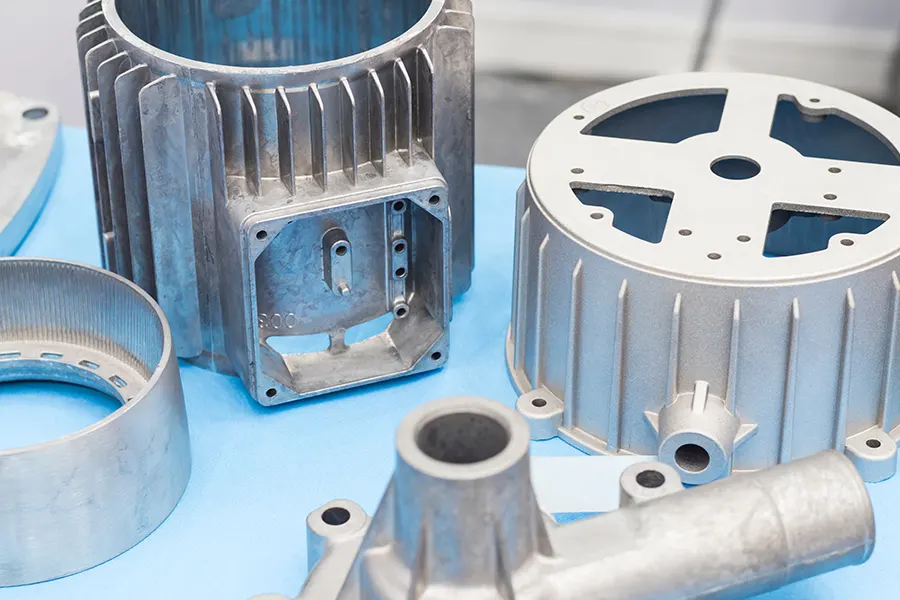
fundición a presión es un proceso de fabricación que implica Inyectar metal fundido en la cavidad de un molde a alta presión., por lo que la fundición a presión tradicional también se llama fundición a alta presión. Luego el metal se enfría y solidifica., dando como resultado un componente fundido que se asemeja mucho a la forma y dimensiones del molde. Este proceso es adecuado para producir alto volumen, Piezas complejas con excelente precisión dimensional..
En comparación con otros métodos de fabricación como la fundición en arena o la fundición a la cera perdida., La fundición a presión ofrece varias ventajas.. Permite la producción de piezas con paredes delgadas y detalles intrincados., reduciendo la necesidad de mecanizado adicional. Además, La fundición a presión tiene una mayor tasa de producción., menores costos laborales, y puede lograr tolerancias más estrictas.
Ventajas y desventajas de la fundición a presión
Ventajas de la fundición a presión
- Alta productividad: La fundición a presión puede producir una gran cantidad de piezas rápidamente, lo que resulta en ahorro de tiempo y costos.
- Precisión dimensional: Las piezas fabricadas mediante fundición a presión reproducen fielmente las especificaciones deseadas., reduciendo la necesidad de mecanizado adicional.
- Solución rentable: La fundición a presión minimiza los costos de mano de obra y los requisitos de posprocesamiento., proporcionando ahorros de costos a largo plazo.
- Geometría compleja: La fundición a presión permite la producción de diseños intrincados y piezas complejas..
Desventajas de la fundición a presión
- Alto coste inicial de herramientas: Crear moldes para fundición a presión puede resultar caro, especialmente para la producción a pequeña escala.
- Limitaciones de tamaño: La fundición a presión es más adecuada para piezas de tamaño pequeño a mediano..
- Vida limitada del molde: La inyección repetida a alta presión puede provocar desgaste en los moldes., que requiere reemplazo o reparación.
- Selección de material restringida: La fundición a presión puede tener limitaciones en la elección de materiales en comparación con otros métodos..
Materiales utilizados en la fundición a presión
La fundición a presión se puede realizar con una variedad de metales y aleaciones., incluido aluminio, zinc, y magnesio. Cada aleación ofrece propiedades y ventajas únicas., haciéndolos adecuados para diferentes aplicaciones.
Fundición a presión de aluminio
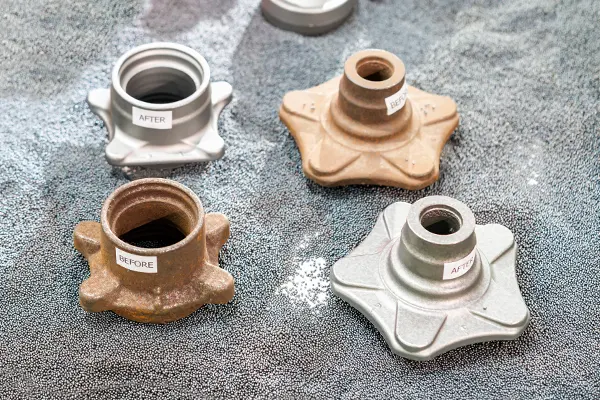
El aluminio es uno de los metales más utilizados para la fundición a presión debido a su Excelente relación resistencia-peso y resistencia a la corrosión.. Es ligero, todavía durable, haciéndolo ideal para componentes automotrices, cajas electrónicas, y bienes de consumo.
La fundición a presión de aluminio ofrece varias ventajas, como una alta conductividad térmica, buena maquinabilidad, y excelente estabilidad dimensional. También permite la producción de piezas de paredes delgadas con formas complejas., reduciendo la necesidad de operaciones de mecanizado adicionales.
Fundición a presión de zinc

El zinc es otra opción popular para la fundición a presión., conocido por sus excelentes propiedades de fundición y bajo punto de fusión. Se utiliza comúnmente en la producción de conectores eléctricos., herrajes decorativos, y componentes de automoción.
Ofertas de fundición a presión de zinc. Excelente fluidez y moldeabilidad precisa., permitiendo la producción de piezas complejas y de paredes delgadas. También proporciona buena resistencia a la corrosión y excelente acabado superficial., lo que lo convierte en una opción rentable para muchas aplicaciones.
Fundición a presión de latón

Latón, una aleación de cobre y zinc, Es ampliamente utilizado en fundición a presión debido a sus propiedades únicas.. Las piezas fundidas de latón ofrecen una excelente resistencia a la corrosión., buenas propiedades mecánicas, y alta maquinabilidad. Se emplean comúnmente en diversas aplicaciones que requieren tanto atractivo estético como propiedades funcionales.. Algunas aplicaciones comunes de las piezas de fundición a presión de latón incluyen accesorios de plomería., herrajes decorativos, conectores electricos, e instrumentos musicales.
Fundición a presión de magnesio

El magnesio es un metal liviano con una excelente relación resistencia-peso., haciéndolo ideal para aplicaciones donde la reducción de peso es crucial. Se utiliza a menudo en la industria aeroespacial., componentes automotrices, y dispositivos electrónicos.
La fundición a presión de magnesio ofrece una estabilidad dimensional excepcional, alta conductividad térmica, y excelentes propiedades de blindaje electromagnético. También proporciona una fuerte resistencia a la corrosión y es fácilmente reciclable., convirtiéndolo en una opción respetuosa con el medio ambiente.
3 Tipos de procesos de fundición a presión
Ciertamente! Aquí hay una tabla comparativa para la fundición a presión en cámara fría., Fundición a presión en cámara caliente, y fundición a presión al vacío:
| Fundición a presión en cámara fría | Fundición a presión en cámara caliente | Fundición a presión al vacío | |
| Materiales adecuados | Aluminio, magnesio, cobre, varias aleaciones | Zinc, dirigir, aleaciones de estaño | Aluminio, magnesio, cobre, varias aleaciones |
| Método de operación | El metal fundido se vierte desde un horno independiente. | El metal fundido se bombea directamente al molde. | El metal fundido se vierte en una cámara sellada. |
| Temperatura del proceso | Temperatura más alta | Temperatura más baja (cerca del punto de fusión) | Temperatura más baja (por debajo del punto de fusión) |
| Complejidad de las piezas Producido | Capaz de producir piezas más complejas con paredes más gruesas. | Se adapta a piezas más simples y pequeñas. | Adecuado para piezas complejas |
| Costo del equipo | Se requiere una configuración de equipo más costosa | Se requiere una configuración de equipo menos costosa | Se requiere una configuración moderada del equipo |
| Usos en industrias | Automotor, aeroespacial, bienes de consumo, electrónica, etc.. | Pequeños electrodomésticos, componentes de plomería, etc.. | Aeroespacial, automotor, médico, dispositivos electronicos, etc.. |
Tenga en cuenta que la tabla anterior es una comparación general y es posible que no cubra todos los aspectos de cada uno.
Fundición a presión en cámara fría
¿Qué es la fundición a presión en cámara fría?? Fundición a presión en cámara fría, el metal fundido se vierte en una cámara separada y luego se inyecta en la cavidad del molde usando un émbolo. Este método es adecuado para aleaciones con puntos de fusión altos., como aluminio y cobre.
La fundición a presión en cámara fría se utiliza comúnmente en la producción de componentes automotrices., piezas aeroespaciales, y piezas fundidas más grandes que requieren alta presión.
Fundición a presión en cámara caliente
¿Qué es la fundición a presión en cámara caliente?? La fundición a presión en cámara caliente es un proceso en el que el mecanismo de inyección está integrado en el horno.. El metal fundido se suministra continuamente., eliminando la necesidad de una cámara separada. Este método es adecuado para aleaciones con puntos de fusión bajos., como zinc y magnesio.
La fundición a presión en cámara caliente se emplea a menudo en la producción de piezas más pequeñas., partes intrincadas, como conectores electrónicos, pequeños componentes automotrices, y electrodomésticos.
Fundición a presión al vacío
La fundición a presión al vacío es una variación del proceso tradicional de fundición a presión en el que se aplica un vacío durante la etapa de inyección.. Esto ayuda a eliminar los gases atrapados y reducir la porosidad en las piezas fundidas finales., dando como resultado propiedades mecánicas mejoradas.
La fundición a presión al vacío se utiliza ampliamente en industrias donde la alta calidad, Las piezas fundidas sin defectos son fundamentales, como aeroespacial, médico, e ingeniería de precisión.
El proceso de fundición a presión
Paso #1: Diseño de molde
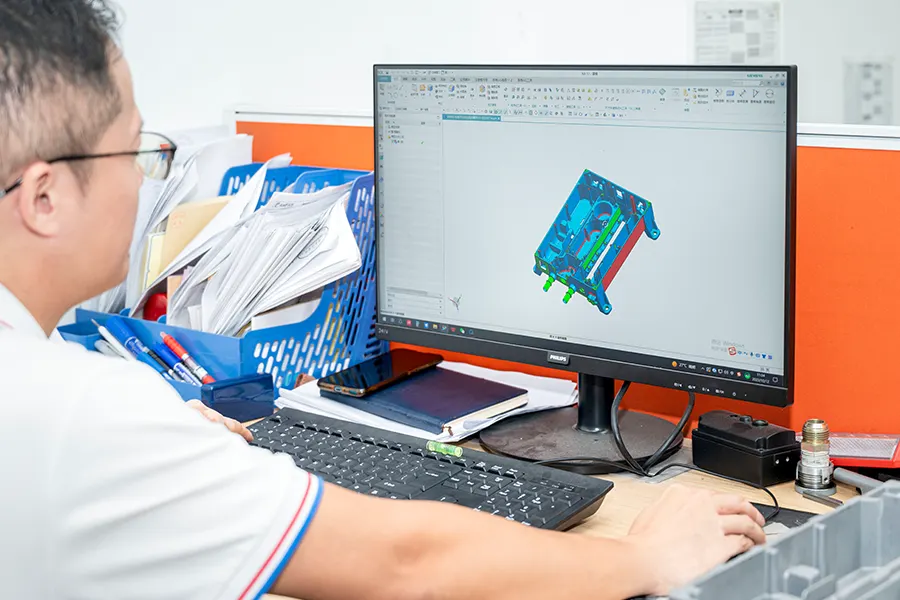
El primer paso en el proceso de fundición a presión es el diseño y fabricación del molde.. El molde debe diseñarse para soportar alta presión y temperatura manteniendo la forma y dimensiones deseadas de la pieza final..
Paso #2: Preparación del casting
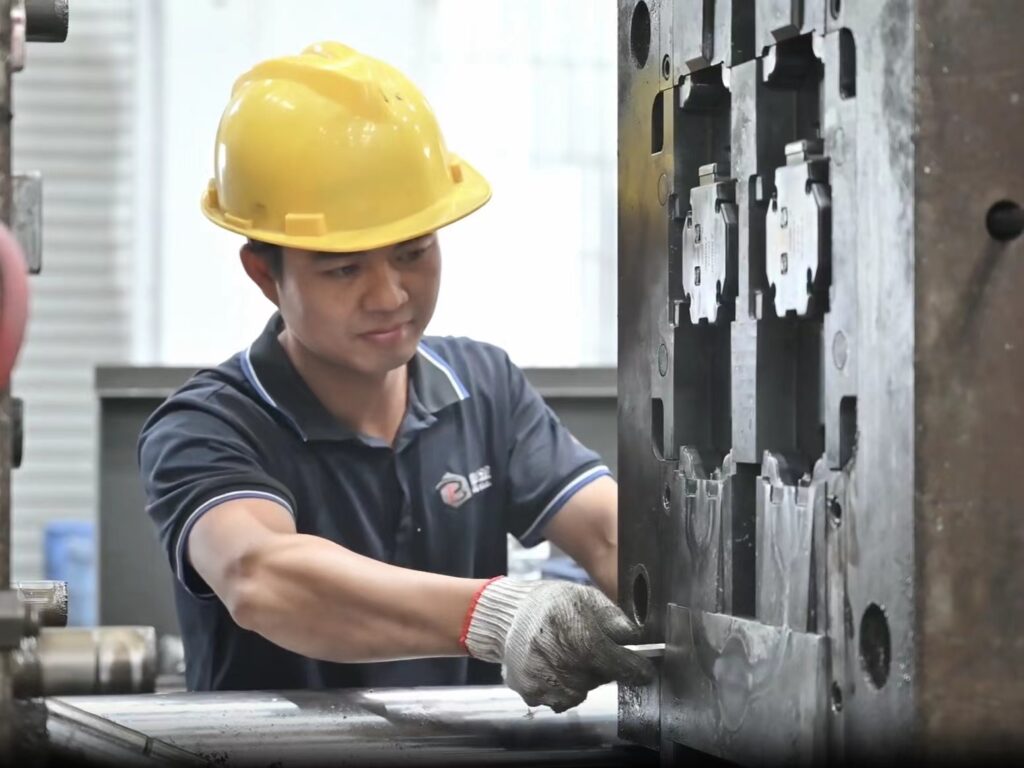
Una vez que el molde esté listo, Se precalienta a la temperatura deseada para garantizar una transferencia de calor adecuada durante el proceso de fundición.. Se aplican al molde todos los agentes desmoldantes o recubrimientos necesarios para evitar que se pegue y facilitar la extracción de piezas..
Paso #3: Inyección

El metal fundido se inyecta en la cavidad del molde a alta presión mediante un émbolo o un pistón hidráulico.. La alta presión ayuda a llenar el molde por completo y garantiza una buena precisión dimensional y acabado superficial..
Paso #4: Enfriamiento y solidificación
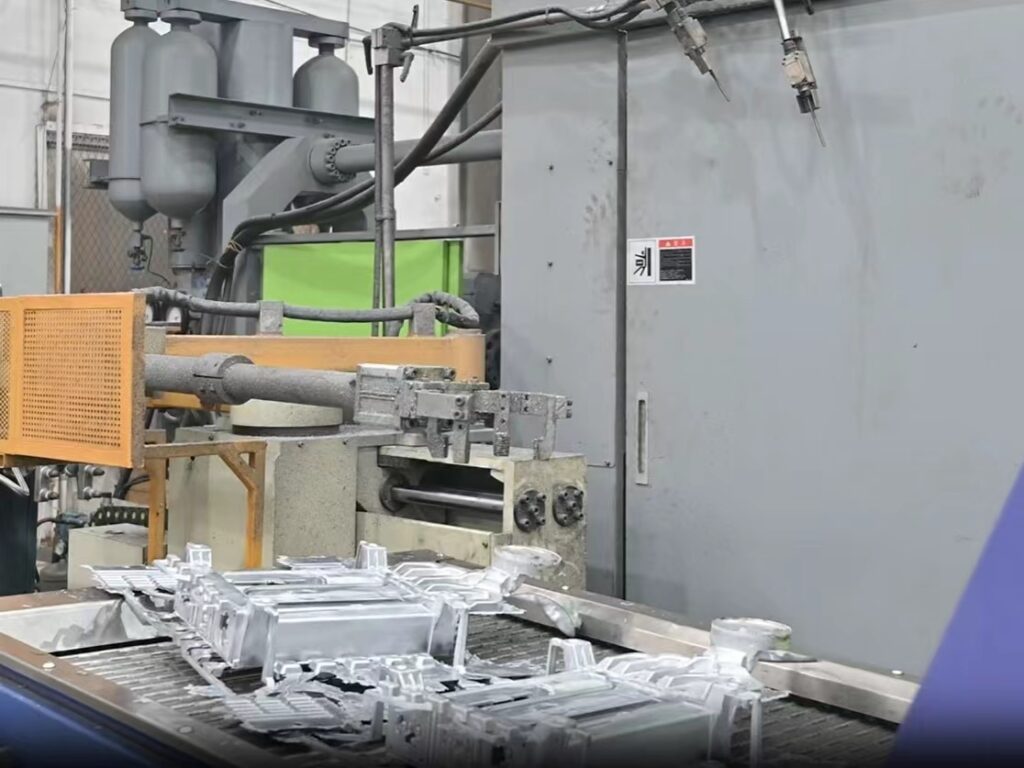
Después de la inyección, El metal fundido se deja enfriar y solidificar dentro de la cavidad del molde.. El tiempo de enfriamiento varía según el material y la geometría de la pieza., pero es crucial controlar la velocidad de enfriamiento para evitar defectos como contracción o porosidad..
Paso #5: Desmoldeo / Eliminación
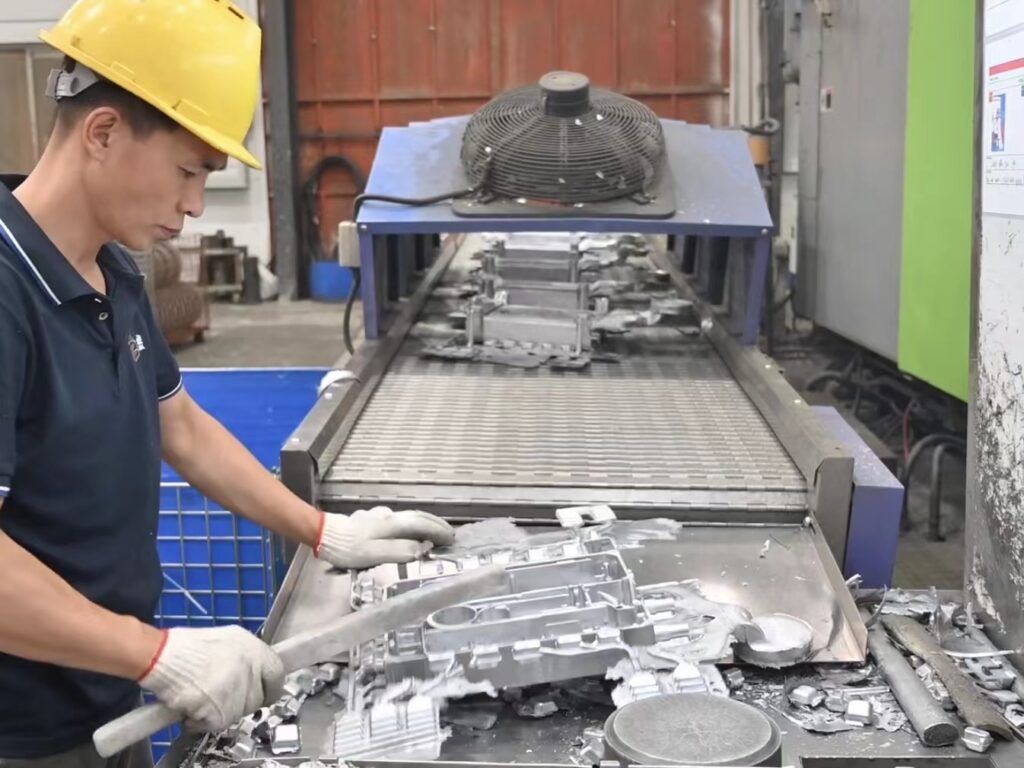
Una vez solidificada la pieza, se abre el molde, y se retira el yeso. Se debe tener cuidado para evitar cualquier daño a la pieza durante el desmoldeo..
Paso #6: Mecanizado CNC / Tratamiento de superficies

En algunos casos, Es posible que se requieran operaciones de mecanizado adicionales para lograr la forma deseada., dimensiones, o acabado superficial. Esto se puede hacer usando Mecanizado CNC, perforación, tocando, u otras técnicas de posprocesamiento. Tratamientos superficiales como enchapado, cuadro, También se puede aplicar recubrimiento en polvo para mejorar la apariencia y la resistencia a la corrosión de la pieza..
Aplicaciones de fundición a presión en todas las industrias

Industria automotriz
La fundición a presión juega un papel vital en la industria automotriz proporcionando piezas ligeras pero duraderas, como componentes del motor, carcasas de transmision, y componentes del cuerpo. Ayuda a mejorar la eficiencia del combustible., reducir las emisiones, y mejorar el rendimiento general del vehículo.
Industria aeroespacial
En la industria aeroespacial, La fundición a presión se utiliza para producir componentes críticos que requieren alta resistencia., precisión dimensional, y propiedades ligeras. Piezas como palas de turbina., componentes estructurales de aeronaves, y las carcasas del motor se fabrican comúnmente mediante el proceso de fundición a presión..
Industria Electrónica y Telecomunicaciones
La fundición a presión se emplea ampliamente en el industria electrónica y de telecomunicaciones para producir componentes como conectores, carcasas, y disipadores de calor. El proceso permite diseños complejos., excelente disipación de calor, y propiedades de blindaje electromagnético.
Bienes de consumo y electrodomésticos
Muchos bienes de consumo y electrodomésticos dependen de la fundición a presión para la producción de diversos componentes.. De desde electrodomésticos de cocina hasta herramientas eléctricas, La fundición a presión proporciona la durabilidad., fortaleza, y dimensiones precisas requeridas para estos productos.
Sector médico y sanitario
El sector médico y sanitario utiliza la fundición a presión para la producción de instrumentos quirúrgicos., dispositivos médicos, y componentes del equipo. La fundición a presión ofrece la precisión necesaria, limpieza, y esterilizabilidad requerida en esta industria..
Conclusión
La fundición a presión es un proceso de fabricación versátil y ampliamente utilizado que permite la producción de piezas metálicas complejas y de alta calidad.. Comprender los conceptos básicos de la fundición a presión, los materiales utilizados, varios procesos de fundición a presión, y sus aplicaciones en todas las industrias es esencial para cualquier persona involucrada en el campo de la fabricación o la ingeniería.. Aprovechando las ventajas y capacidades de la fundición a presión, Los fabricantes pueden producir piezas que cumplan con los exigentes requisitos de las industrias actuales..
Preguntas frecuentes
1. ¿Qué es el flash en la fundición a presión??
La rebaba en la fundición a presión se refiere al exceso de material que se exprime entre las dos mitades de la matriz durante el proceso de fundición., creando protuberancias no deseadas en la superficie de fundición.
2. ¿Qué es la fundición a presión por gravedad??
Fundición a presión por gravedad, o fundición en molde permanente, Es un proceso de fundición en el que el metal fundido se vierte en un molde reutilizable utilizando la gravedad para ayudar a llenar la cavidad del molde., dando como resultado piezas fundidas de alta calidad.
3. ¿Qué es la fundición a presión de aluminio??
La fundición a presión de aluminio es un proceso que utiliza una aleación de aluminio fundido inyectada en una cavidad de molde a alta presión para producir piezas fundidas precisas y livianas para diversas industrias..
4. ¿Qué es la fundición en molde??
La fundición en molde es un término amplio que abarca procesos de fundición que utilizan moldes para dar forma y solidificar materiales fundidos como metal o plástico en la forma deseada..
5. ¿Para qué se utiliza la fundición a presión??
La fundición a presión se utiliza ampliamente en industrias como la automotriz., aeroespacial, y electrónica para producir componentes metálicos complejos y de alta calidad con excelente precisión dimensional a un ritmo de producción rápido.
6. ¿Cuáles son los metales más comunes utilizados en la fundición a presión??
Los metales más comunes utilizados en la fundición a presión son el aluminio., zinc, y magnesio. Estos metales ofrecen excelentes propiedades para el proceso de fundición a presión., como buena fluidez, conductividad térmica, y relación fuerza-peso. Otros metales, incluyendo latón y cobre, También se utilizan en fundición a presión., aunque son menos comunes que el aluminio, zinc, y magnesio.

